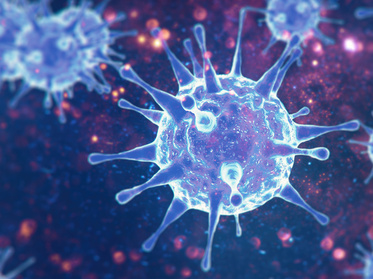
New discovery on coronavirus entry receptors in human cells
In a study published in Nature, researchers from the Institut Pasteur, Université Paris Cité and the Vaccine Research Institute (VRI) have identified the entry point of a seasonal coronavirus, the HKU1 virus, into human cells.
Last updated on 15 November 2023
Some coronaviruses are well known: SARS-CoV-2, which appeared in 2019 and is responsible for the March 2020 pandemic, but also SARS-CoV-1 and Mers-CoV, responsible respectively for Severe Acute Respiratory Syndrome (SARS) and Middle East Respiratory Syndrome (MERS). But these three coronaviruses are not the only ones capable of infecting humans. There are also four others, generally responsible for mild seasonal colds: HKU1, 229E, NL63 and OC43.
The HKU1 virus was first identified in 2005. Like SARS-CoV-2, it primarily infects the cells of the upper respiratory tract, but rarely reaches the bronchi and pulmonary alveoli, causing mild colds and respiratory symptoms. The difference in severity between these different coronaviruses could be explained in part by the difference in receptors to which HKU1 and SARS-CoV-2 bind.
Researchers at the Institut Pasteur, Université Paris Cité and the Vaccine Research Institute (VRI) have identified the HKU1 virus’ entry point into human cells.
HKU1 virus entry point identified
In order to infect a cell, coronaviruses must bind to a receptor on the cell surface with which they have an affinity. This binding mechanism is essential for virus fusion, leading to entry into the cell. Saunders et al. identified the TMPRSS2 enzyme as a high-affinity receptor for HKU1 binding, unlike SARS-CoV-2, which uses the ACE2 receptor to infect human cells.
The use of different receptors may affect the severity of these human pathogenic viruses as the presence of receptors varies between cells of the respiratory track, thus influencing cell sensitivity to infection and viral propagation. Characterising the different cellular entry mechanisms of coronaviruses should facilitate the development of improved targeted therapies, and assess the risk of virulence of future coronaviruses that may emerge.
Funding
This work was funded by Institut Pasteur, Université Paris Cité and Vaccine Research Institute, as well as by Fondation pour la Recherche Médicale (FRM), ANRS | Emerging Infectious Diseases, European HERA DURABLE project, Labex IBEID, and ANR/FRM Flash Covid project.
Find out more Read the study